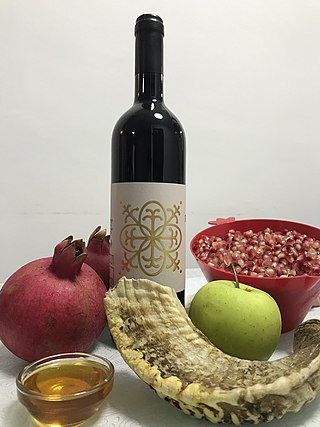Related Research Articles

Yom Kippur is the holiest day of the year in Judaism and Samaritanism. It occurs annually on the 10th of Tishrei, corresponding to a date in late September or early October.

Kiddush, literally, "sanctification", is a blessing recited over wine or grape juice to sanctify the Shabbat and Jewish holidays. Additionally, the word refers to a small repast held on Shabbat or festival mornings after the prayer services and before the meal.
The Three Weeks or Bein ha-Metzarim is a period of mourning commemorating the destruction of the first and second Jewish Temples. The Three Weeks start on the seventeenth day of the Jewish month of Tammuz—the fast of Shiva Asar B'Tammuz—and end on the ninth day of the Jewish month of Av—the fast of Tisha B'Av, which occurs exactly three weeks later. Both of these fasts commemorate events surrounding the destruction of the Jewish Temples and the subsequent exile of the Jews from the land of Israel. According to conventional chronology, the siege of Jerusalem by Nebuchadnezzar II occurred in 586/7 BCE, and the second siege of Jerusalem (70) by the Romans, in 70 CE. Jewish chronology, however, traditionally places the first destruction at about 421 BCE.

Challah is a special bread of Ashkenazi Jewish origin, usually braided and typically eaten on ceremonial occasions such as Shabbat and major Jewish holidays. Ritually acceptable challah is made of dough from which a small portion has been set aside as an offering. Challah may also refer to the dough offering. The word is biblical in origin, meaning "loaf". Similar braided breads such as kalach and vánočka are found across Central and Eastern Europe.

Jewish cuisine refers to the worldwide cooking traditions of the Jewish people. During its evolution over the course of many centuries, it has been shaped by Jewish dietary laws (kashrut), Jewish festivals and holidays, and traditions centred around Shabbat. Jewish cuisine is influenced by the economics, agriculture, and culinary traditions of the many countries where Jewish communities have settled and varies widely throughout the entire world.

Kreplach are small dumplings in Ashkenazi Jewish cuisine filled with ground meat, mashed potatoes or another filling, usually boiled and served in chicken soup, though they may also be served fried. They are similar to Polish pierogi, Polish and Ukrainian uszka, Russian pelmeni, Italian ravioli or tortellini, German Maultaschen, and Chinese jiaozi and wonton. The dough is traditionally made of flour, water and eggs, kneaded and rolled out thin. Some modern-day cooks use frozen dough sheets or wonton wrappers. Ready-made kreplach are also sold in the kosher freezer section of supermarkets.

A ta'anit or taynis is a fast in Judaism in which one abstains from all food and drink, including water.

Yemeni cuisine is distinct from the wider Middle Eastern cuisines, but with a degree of regional variation. Although some foreign influences are evident in some regions of the country, the Yemeni kitchen is based on similar foundations across the country.

Sephardic Jewish cuisine is an assortment of cooking traditions that developed among the Sephardi Jews.

Israeli cuisine primarily comprises dishes brought from the Jewish diaspora, and has more recently been defined by the development of a notable fusion cuisine characterized by the mixing of Jewish cuisine and Arab cuisine. It also blends together the culinary traditions of the various diaspora groups, namely those of Middle Eastern Jews with roots in Southwest Asia and North Africa, Sephardi Jews from Iberia, and Ashkenazi Jews from Central and Eastern Europe.

A break-fast is a meal eaten after fasting.
In Judaism, when the Eve of Passover falls on Shabbat, special laws regarding the preparation for Passover are observed.

Rosh HaShanah is the Jewish New Year. The biblical name for this holiday is Yom Teruah. It is the first of the Jewish High Holy Days, as specified by Leviticus 23:23–25, that occur in the late summer/early autumn of the Northern Hemisphere. Rosh Hashanah begins a ten-day period of penitence culminating in Yom Kippur, as well as beginning the cycle of autumnal religious festivals running through Sukkot and ending in Shemini Atzeret in Israel and in Simchat Torah everywhere else.

Mizrahi Jewish cuisine is an assortment of cooking traditions that developed among the Jews of the Middle East, North Africa, Asia, and Arab countries. Mizrahi Jews have also been known as Oriental Jews.

Ashkenazi Jewish cuisine is an assortment of cooking traditions that was developed by the Ashkenazi Jews of Central, Eastern, Northwestern and Northern Europe, and their descendants, particularly in the United States and other Western countries.
Pain petri is a braided bread of Moroccan Jewish origin, that is traditionally baked for Shabbat, the Jewish sabbath, as well as Rosh Hashanah and other Holidays, and is popular among the Moroccan Jewish community of Morocco, France, and Israel.

Resek agvaniyot, or resek, is an Israeli condiment made of grated tomatoes that is traditionally served with malawach, jachnun, bourekas, kubaneh, and other dishes. It is frequently paired with zhug, and is also commonly served as part of the Israeli breakfast.

Fatoot samneh is a dish originating in Yemeni cuisine, consisting of pieces of saluf or malawach, or pita, that have been fried in clarified butter and combined with beaten egg. It is commonly served as a breakfast or dinner dish. It was brought to Israel by Yemenite Jews. It is somewhat similar to the Jewish matzah brei or the Mexican-American migas, which are made with matzo, and corn tortillas, respectively; whereas fatoot samneh is made with pita bread.
Boulou, also known as boulous, is a Libyan Jewish sweet bread or cake of Maghrebi Jewish origin, similar to mouna, tishpishti, or pound cake, that is traditionally made into loaves or rolls and consumed as part of the meal preceding the Yom Kippur Fast, or as part of the break fast that follows. It is most commonly found today in France, and Israel. Boulou has a sweet taste enriched with sugar, eggs, honey, oil, and golden raisins it often contains seeds such as fennel, sesame, and nigella seeds.